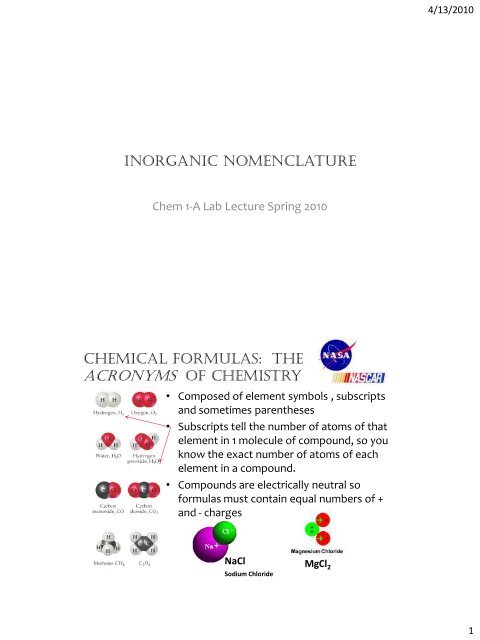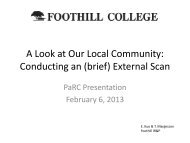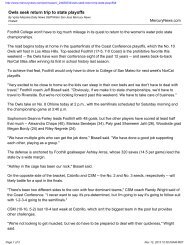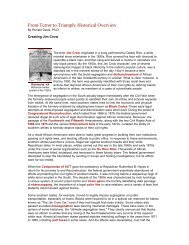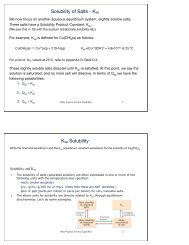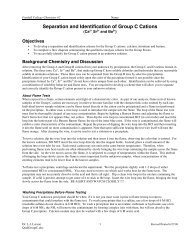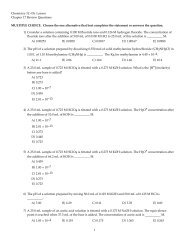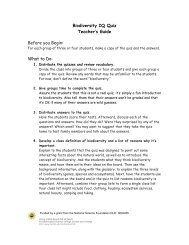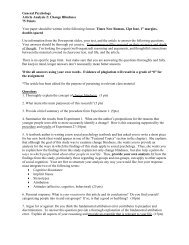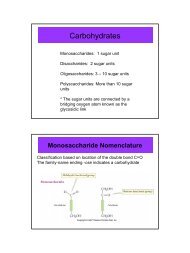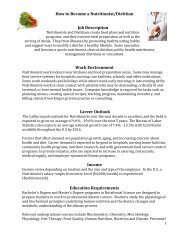Chemical Formulas: the acronyms of chemistry
Chemical Formulas: the acronyms of chemistry
Chemical Formulas: the acronyms of chemistry
Create successful ePaper yourself
Turn your PDF publications into a flip-book with our unique Google optimized e-Paper software.
Inorganic Nomenclature<br />
Chem 1-A Lab Lecture Spring 2010<br />
<strong>Chemical</strong> <strong>Formulas</strong>: <strong>the</strong><br />
<strong>acronyms</strong> <strong>of</strong> <strong>chemistry</strong><br />
• Composed <strong>of</strong> element symbols , subscripts<br />
and sometimes paren<strong>the</strong>ses<br />
• Subscripts tell <strong>the</strong> number <strong>of</strong> atoms <strong>of</strong> that<br />
element in 1 molecule <strong>of</strong> compound, so you<br />
know <strong>the</strong> exact number <strong>of</strong> atoms <strong>of</strong> each<br />
element in a compound.<br />
• Compounds are electrically neutral so<br />
formulas must contain equal numbers <strong>of</strong> +<br />
and - charges<br />
NaCl<br />
Sodium Chloride<br />
MgCl 2<br />
4/13/2010<br />
1
<strong>Formulas</strong> and Names<br />
You need to be able to write:<br />
The formula when given a name<br />
The name when given a formula<br />
• CaO is calcium oxide<br />
– How did I know that?<br />
• The formula for sodium nitrate is NaNO 3<br />
– That one is even less obvious<br />
• How about ammonium carbonate?<br />
– Yikes!<br />
• Or how do I name NaHCO 3?<br />
Start with <strong>the</strong> Exceptions<br />
Memorize <strong>the</strong>se common names and formulas:<br />
H 2O = Water, steam, ice.<br />
NH 3 = Ammonia.<br />
CH 4 = Methane.<br />
NaCl = Table salt.<br />
C 12H 22O 11 = Table sugar.<br />
4/13/2010<br />
2
<strong>Chemical</strong> Bonds<br />
To name compounds or write formulas we<br />
have to know how <strong>the</strong> atoms are connected<br />
toge<strong>the</strong>r:<br />
– Ionic bonds: electron transfer ex: Na + Cl- Very strong bonds; high melting and boiling<br />
points, usually have a metal cation<br />
– Covalent (molecular) bonds: electron sharing<br />
Form between nonmetals; vary in strength<br />
from very strong bonds to weaker bonds<br />
We name ionic compounds, molecular<br />
compounds and acids differently.<br />
Polyatomic Ions: atom wannabes<br />
• Certain groups <strong>of</strong> atoms act as a unit (as if <strong>the</strong>y were<br />
one atom) in chemical reactions.<br />
– These groups <strong>of</strong> atoms contain more than one kind <strong>of</strong> atom, so<br />
<strong>the</strong>y are called polyatomic. Their atoms are held toge<strong>the</strong>r by<br />
covalent bonds<br />
– They have a charge (usually having gained a few electrons) , so<br />
<strong>the</strong>y are called polyatomic ions<br />
– They have <strong>the</strong>ir own names! (which you must learn)<br />
– We find <strong>the</strong>m in ionic compounds and oxoacids<br />
• In formulas, polyatomic ions are set <strong>of</strong>f in paren<strong>the</strong>ses (if<br />
<strong>the</strong>re are more than one <strong>of</strong> <strong>the</strong>m)<br />
– More on this later…….<br />
NO 3 -<br />
NH 4 +<br />
OH -<br />
SO 4 2-<br />
4/13/2010<br />
3
Polyatomic Ions - Learn <strong>the</strong>se<br />
Ions with -1 charge<br />
perchlorate ClO 4 -1<br />
chlorate ClO 3 -1<br />
chlorite ClO 2 -1<br />
hypochlorite ClO -1<br />
perbromate BrO 4 -1<br />
bromate BrO 3 -1<br />
bromite BrO 2 -1<br />
hypobromite BrO -1<br />
periodate IO 4 -1<br />
iodate IO 3 -1<br />
iodite IO 2 -1<br />
hypoiodite IO -1<br />
nitrate NO 3 -1<br />
nitrite NO 2 -1<br />
hydroxide OH -1<br />
cyanide CN -1<br />
thiocyanate SCN -1<br />
acetate C 2H 3O 2 -1<br />
permanganate MnO 4 -1<br />
bicarbonate HCO 3 -1<br />
Ions with a -2 Charge<br />
carbonate CO 3 -2<br />
sulfate SO 4 -2<br />
sulfite SO 3 -2<br />
chromate CrO 4 -2<br />
dichromate Cr 2O 7 -2<br />
oxalate C 2O 4 -2<br />
peroxide O 2 -2<br />
Ions with -3 charge<br />
phosphate PO 4 -3<br />
phosphite PO 3 -3<br />
Ions with +1 charge<br />
ammonium ion NH 4 +1<br />
hydronium ion H3O +<br />
The most productive<br />
method <strong>of</strong> committing<br />
<strong>the</strong>se ions to memory is<br />
first memorize <strong>the</strong> ones<br />
that have <strong>the</strong> “ate”<br />
ending. This is <strong>the</strong> most<br />
common ending.<br />
Classifying Substances for Naming and Writing<br />
<strong>Formulas</strong><br />
4/13/2010<br />
4
Ionic Compounds<br />
• Ionic compounds are made <strong>of</strong> ions, usually a<br />
metal + nonmetal or metal + polyatomic ion<br />
• No individual molecule units, instead have a 3-D<br />
array <strong>of</strong> cations and anions made <strong>of</strong> formula<br />
units.<br />
NaCl formula unit<br />
Sodium Chloride<br />
• Ionic compounds always contain cations and<br />
anions.<br />
• The sum <strong>of</strong> <strong>the</strong> + charges <strong>of</strong> <strong>the</strong> cations must<br />
equal <strong>the</strong> sum <strong>of</strong> <strong>the</strong> − charges <strong>of</strong> <strong>the</strong> anions.<br />
Naming Ionic Compounds<br />
1. Identify <strong>the</strong> cation (metal) and anion (non metal or<br />
polyatomic ion.<br />
2. Name by simply naming <strong>the</strong> ions.<br />
– The cation comes first. If <strong>the</strong> cation is:<br />
• Type I metal (can find charge on chart) = Metal name.<br />
• Type II metal (can’t predict charge) = Metal name (charge).<br />
• Polyatomic ion = Name <strong>of</strong> polyatomic ion.<br />
– The anion is named second: If <strong>the</strong> anion is a:<br />
• Nonmetal = Stem/base <strong>of</strong> nonmetal name + -ide.<br />
– For example oxygen becomes oxide; sulfur becomes sulfide<br />
• Polyatomic ion = Name <strong>of</strong> polyatomic ion.<br />
4/13/2010<br />
5
Ions<br />
Ni 2+ Zn 2+<br />
Ag + Cd 2+<br />
• We know whe<strong>the</strong>r an atom forms a ca+ion or anion by its<br />
position on <strong>the</strong> chart:<br />
– Metals form cations having <strong>the</strong> same charge as <strong>the</strong>ir group<br />
number for Group A metals (Type I metals, also Ag + , Cd 2+ , Ni 2+ , Zn 2+ )<br />
– Transition metals also form cations, but <strong>the</strong>ir charges are not<br />
predictable (aka Type II metals)<br />
– Nonmetals form anions (- charge)<br />
• Formed by elements on right side <strong>of</strong> chart (nonmetals).<br />
• Their charges are Group Number - 8<br />
Metal Cations: Type I or Type 2?<br />
• Type I metals<br />
– Metals whose ions only have one possible charge.<br />
• Group 1A , 2A, 3A (Al 3+ , Ga 3+ , In 3+ )<br />
– Determine charge by position on periodic table.<br />
• 1A = +, 2A = 2+, 3A = 3+.<br />
4 transition metals need to be memorized:<br />
• Ag + , Cd 2+ , Ni 2+ , Zn 2+<br />
• Type II (Note: Being a Type II metal does not mean <strong>the</strong> charge is 2+)<br />
– If not Type I, <strong>the</strong>n it’s Type II<br />
– Metals whose ions have >1 possible charge (transition metals)<br />
– Determine <strong>the</strong> metal cation charge by looking at <strong>the</strong> charge on<br />
<strong>the</strong> anion in <strong>the</strong> compound.<br />
4/13/2010<br />
6
Nonmetal Anions: Special Naming<br />
• Determine <strong>the</strong> charge from position on <strong>the</strong> periodic table.<br />
• To name anion, change ending on <strong>the</strong> element name to –ide.<br />
Group 4A<br />
-4<br />
Group 5A<br />
-3<br />
Group 6A<br />
-2<br />
Group 7A<br />
-1<br />
C = Carbide N = Nitride O = Oxide F = Fluoride<br />
Si = Silicide P = Phosphide S = Sulfide Cl = Chloride<br />
Molecular Compounds<br />
• Two or more nonmetals.<br />
• Smallest unit is a molecule.<br />
• They form electron-sharing<br />
or covalent bonds<br />
table sugar<br />
ethanol<br />
hydrogen disulfide<br />
4/13/2010<br />
7
Binary Molecular Compounds<br />
1. Name first element in formula first.<br />
– Use <strong>the</strong> full name <strong>of</strong> <strong>the</strong> element.<br />
2. Name <strong>the</strong> second element in <strong>the</strong> formula with an<br />
−ide, as if it were an anion.<br />
3. Use a prefix in front <strong>of</strong> each name to indicate <strong>the</strong><br />
number <strong>of</strong> atoms (Only molecular compounds get<br />
prefixes).<br />
– Never use <strong>the</strong> prefix mono- on <strong>the</strong> first element.<br />
Prefixes for molecular compounds<br />
• 1 = mono-<br />
– Not used on first nonmetal.<br />
• 2 = di-<br />
• 3 = tri-<br />
• 4 = tetra-<br />
• 5 = penta-<br />
• 6 = hexa-<br />
• 7 = hepta-<br />
• 8 = octa-<br />
• Drop last “a” if name begins with vowel:<br />
CO = carbon monoxide, not carbon mono oxide<br />
4/13/2010<br />
8
Order <strong>of</strong> Elements in a Formula<br />
Order <strong>of</strong> Listing Nonmetals<br />
in <strong>Chemical</strong> <strong>Formulas</strong><br />
are written this order:(Where are <strong>the</strong>y?)<br />
• How would you write <strong>the</strong>se formulas?<br />
– A compound is made <strong>of</strong> two atoms <strong>of</strong> bromine and one atom <strong>of</strong><br />
calcium.<br />
– Ano<strong>the</strong>r compound is made <strong>of</strong> one atom <strong>of</strong> carbon, one atom <strong>of</strong><br />
magnesium and three atoms <strong>of</strong> oxygen<br />
– This compound has one atom <strong>of</strong> nitrogen, three atoms <strong>of</strong> oxygen<br />
and one atom <strong>of</strong> sodium<br />
Acids<br />
C P N H S I Br Cl O F<br />
• <strong>Formulas</strong> always start with “H” because all acids<br />
contain H +1 cation(s) and an anion.<br />
– Donate H + in aqueous solution.<br />
– Binary acids have H +1 cation(s) and one kind <strong>of</strong> nonmetal anion.<br />
– Oxyacids have one or more H +1 cations and a polyatomic anion.<br />
4/13/2010<br />
9
Naming Acids<br />
Binary Acids: Names always start with ‘hydro’<br />
Hydro- prefix + stem <strong>of</strong> <strong>the</strong> name <strong>of</strong> <strong>the</strong> nonmetal + -ic suffix.<br />
– Write a hydro- prefix.<br />
– Follow with <strong>the</strong> nonmetal name.<br />
– Change ending on nonmetal name to –ic.<br />
– Write <strong>the</strong> word acid at <strong>the</strong> end <strong>of</strong> <strong>the</strong> name.<br />
– Examples: HCl = hydrochloric acid; HF = hydr<strong>of</strong>luoric acid<br />
Oxyacids: hydrogen + polyatomic ion<br />
Names start with <strong>the</strong> stem <strong>of</strong> polyatomic ion name<br />
– If polyatomic ion ends in –ate = Name <strong>of</strong> polyatomic ion with –ic<br />
– If polyatomic ion ends in –ite = Name <strong>of</strong> polyatomic ion with –ous<br />
– Write <strong>the</strong> word acid at <strong>the</strong> end <strong>of</strong> <strong>the</strong> name<br />
– Examples: H 2SO 4 = sulfuric acid; HClO 2 = chlorous Acid<br />
Beware <strong>the</strong> “ides” <strong>of</strong> NamiNg<br />
“ide” at <strong>the</strong> end <strong>of</strong> a name means <strong>the</strong>re is a non-metal<br />
element, not a polyatomic ion (exceptions: hydroxide ion,<br />
cyanide ion).<br />
Memorize <strong>the</strong>se common names and formulas:<br />
– H 2O = Water, steam, ice NH 3 = Ammonia.<br />
– CH 4 = Methane NaCl = Table salt.<br />
– C 12H 22O 11 = Table sugar.<br />
Elements are named as <strong>the</strong>ir element name<br />
If <strong>the</strong> formula starts with H, it’s an acid<br />
If name ends in “acid”, <strong>the</strong> formula better start with H<br />
And for acids: ate g “icK” and “ite” g “ous”<br />
4/13/2010<br />
10
Formula-to-Name Flowchart<br />
4/13/2010<br />
11


